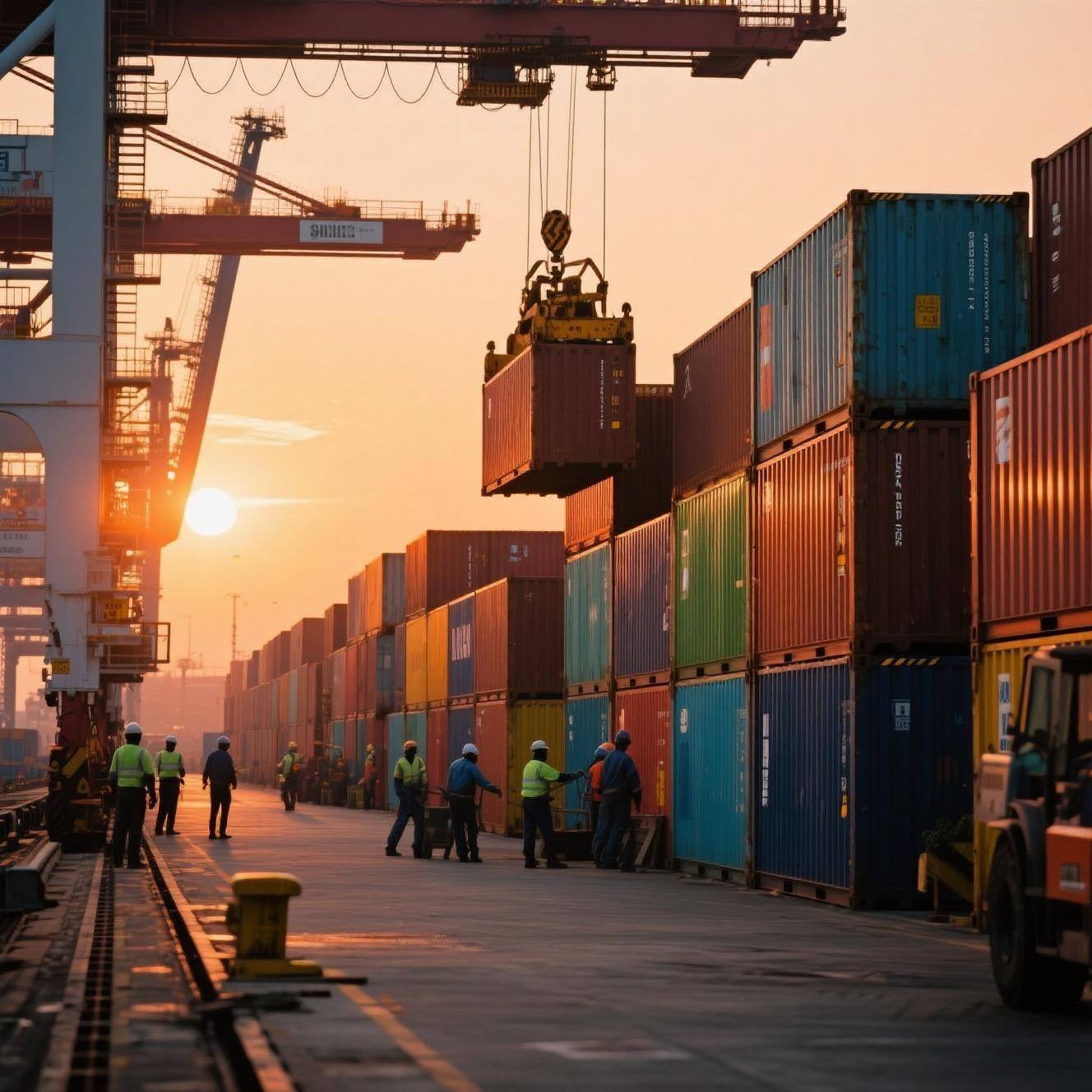יעילות העלות של FCL לשיגרות בהיקף גבוה
חיסכון בעלות ליחידת מוצר עם שימוש מלא בארגז
עבור חברות המשדרות כמויות גדולות של מטענים, משלוחים בשיטת מכולה מלאה (FCL) מציעים חיסכון ממשי בהשוואה לשיטות אחרות. הסיבה העיקרית? כאשר חברה ממלאה מכולה שלמה, יש פחות שטח מבוזבז ופחות חיובים נוספים מצד חברות ההפצה. רוב המומחים ל לוגיסטיקה מסכימים שיעור ניצול של לפחות 80% מהמכולה הוא בעל היגיון כלכלי, ולכן יצרנים ומשווקים רבים מעדיפים את השיטה FCL על פני LCL. חברות המשדרות בכמויות גדולות לרוב נמצאות בתנאי משא ומתן טובים יותר מול חברות ההפצה, מה שמוביל לרווחים גבוהים יותר. שיטה זו עובדת במיוחד יפה עבור יבואנים/יצואנים העוסקים במטענים בכמויות גדולות או מוצרים עונתיים בהם הזמן הוא הגורם הקריטי. מה שמופיע בתעשייה באופן אחיד הוא שהשימוש האינטיליגנטי בשיטת FCL מפחית את עלויות המשלוח הבלתי נמנעות ובעת ואותו זמן תורם להפעלה חלקה של תהליכי הייצור וההפצה.
Conomy של שحن מסיבי בהובלה בינלאומית
כאשר חברות מוצאות מטענים בשיטות מטען מלא (FCL), הן בדרך כלל חוסכות סכומים גדולים בעסקים העולמיים מכיוון שנפחים גדולים מפחיתים את עלות היחידה. השיטה מאפשרת לעסקים לתכנן משלוחים על פי הדרישות האמיתיות של הלקוחות, מה שמעדיף מצבים בהם יש מטענים שלא נמכרו או מדפים ריקים בתקופות שיא. חברות מובילות בתחום המשלוחים מציינות כי שימוש ב-FCL במקום מספר רב של מכולות קטנות יכול להפחית את ההוצאות בטווח של 20% עד 30%. עבור יבואנים ויצואנים רבים, חיסכונות אלה פירושם שהם יכולים להציע מחירים טובים יותר מבלי להקריב רווחים, וכך לפתוח שווקים חדשים בחו''ל. חלק מהיצרנים אף מגלים כי הפחתת ההוצאות מאפשרת השקעה מחדש בתחנות הייצור או בתוכניות הכשרת עובדים.
הידור בדרכים וזמניםי מעבר מהירים יותר
הקטנת העברות המטען במהלך הובלה
המטענים בحاביות מלאות (FCL) מקצרים את הזמן הנדרש להעברת המטענים מצד לצד, מה שפירושו פחות מגע עם המוצרים ופחות סיכוי לפגיעות במהלך הנסיעה. כשחברות מוצאות מוצרים בתוך חאבים ייחודיים, אין צורך להעבר אותם בין אמצעי תחבורה שונים, למשל מהמשאית לספינה וחזרה. לפי נתונים עדכניים מتقارير לוגיסטיים, הקטנת העברות מסוג זה יכולה להאיץ את זמני המשלוחים ב-25% בממוצע. עבור חברות שרוצות לזרז את תהליכי ההפצה, בחירה בFCL היא הגיונית כלכלית ומעשית. המוצרים נשמרים בשלמותם לאורך כל הנסיעה מאחר שכל החומר נשאר במקום אחד ובטוח עד להגעתו ליעדו הסופי.
יתרונות של דרכי הגעה ישירות על פני LCL הרכבה
כאשר חברות בוחרות בשיטת משלוח FCL (/container full load) במקום LCL (less than container load), הן מ prevotas את ההפסקות הבלתי נוחות שנובעות מ המתנה לאיחוי משלוחים רבים. בשיטת FCL, העסקים מקבלים משלוחים בתאריכים מוגדרים שמתאימים לצרכי הייצור שלהם ולצרכי הלקוחות בדיוק בזמן שהם צריכים את זה, מה שמשפר את רמת השירות. מחקר מצביע על כך שמשלוח FCL יכול להפחית את משך הנסיעה בקירכה 15% בהשוואה לשיטות LCL המסורתיות. לייצרנים שמעוניינים להוציא את המוצרים בזמן ולהפעיל את תהליכי הייצור בצורה חלקה, ההבדל הוא משמעותי. שמירה על מועדי משלוח עוזרת לשמירה על שביעות רצון הלקוחות ומשפרת את תפקוד שרשרת האספקה עבור כולם המעורבים.
תהליכי מכס והתיעוד המפשוטים
ניירות של יחיד נושא כדי לפתוח בהקדם
משלוחים באמצעות מכולה מלאה (FCL) הופכים את הטיפול במסמכי המכס לפשוט בהרבה יותר, שכן מעורב רק נמען אחד. הניירות הופכים לפשוטים יותר, מה שפירושו פחות עבודה למערכת ומעבר מהיר דרך תחנות המכס. אין צורך להתמודד עוד עם קבוצות שונות של מסמכים של השולח מקטין טעויות ועיכובים שמתרחשים במשלוחים רבים. לפי מה שאומרים אנשים בתחום, חברות יכולות לחתוך את זמן עיבוד המכס שלהן ב-30% בערך כאשר הן בוחרות FCL במקום מכולה חלקית (LCL). יעילות כזו הופכת את FCL לבחירה חכמה עבור כל אחד שרצוי להעביר סחורות במהירות ובלי עיכובים מיותרים.
הקטנת סיכון לעיכובים בהדוק
בנוגע לבדיקות מכס, משלוחי FCL לרוב נבחרים פחות מאשר משלוחי LCL, שמשכו תשומת לב רבה יותר מצד הרשויות. הרשויות רואות מטען FCL כמגיע ממקור בודד, ולכן הן סוברות שהוא מהווה פחות סיכון בכלל. תפיסה זו מובילה לעיבוד מהיר יותר במעבר הגבול. דוחי תעשייה גם כן תומכים במה שראינו בעבר לא מעט. לפי נתונים סטטיסטיים עדכניים, בערך 15 אחוז פחות מכולות FCL נתקעות ומחכות לבדיקה בהשוואה למשאות מעורבבות. עבור חברות המשלימות סחורות בین-לאומי, ההבדל הזה משמעותי מאוד. פחות זמן המתנה במכס פירושו שהמוצרים מגיעים לשוק בזמן קצר יותר, ולא נתקעים בPaperwork או בהפסקות לא צפויות שיכולות לערער את שרשרת האספקה כולה.
הבטחת אבטחה מתקדמת והגנה של המטען
שימוש ייחודי בכלי אחסון למנוע התערבות של צד שלישי
יתרון גדול אחד כאשר הולכים עם משלוח מלא של המכולות (FCL) הוא כי חברות לקבל את המכולות שלהם כל לעצמם. אין חלל שיתוף עם משלוחים אחרים, כלומר יש הרבה פחות סיכוי שמישהו אחר יוכל להתעסק עם מה שבתוכו. מכולות המוקצות במיוחד לעסק אחד מקשות על כל מי שלא מורשה להיכנס אליהן במהלך התחבורה. דו"חות אבטחה למעשה תומכים בכך גם עסקים המעבירים ל-FCL בדרך כלל רואים ירידה של כ-40 אחוזים בסחורה גנובה בהשוואה כאשר הם השתמשו באפשרויות פחות מטען מכולה (LCL). היתרון האמיתי כאן הוא מטען פשוט נשאר בדיוק כפי שהוא היה ארוז בנקודת ההתחלה עד שהוא מגיע ליעדו ללא כל הפרעה ממקורות חיצוניים לאורך הדרך.
חותמי אבטחה מראים עבור מוצרים בעלי ערך גבוה
משאיירים המובילים פריטים יקרים צריכים לשקול להשתמש בחותמים המעידים על הפרעה במכולות FCL שלהם. מכשירים קטנים אלו עושים יותר מרק לעצור אנשים מהפתיחה של תיבות שלא אמורות להיפתח. הם מעניקים לעסקים ביטחון בכך שאנשים שמעזים לפגוע במטע יותירו ראיות ברורות כשהמכולה תגיע ליעדה. על פי מחקרים מסוימים, חברות שמתחילות להשתמש בחותמים אלו מדווחות על פחות טענות ביטוח על נזקים או גניבות. למה? בגלל שפושעים בדידים חושבים פעמיים לפני שמבצעים כל פעולה כשהסיכוי שיתגלו מייד הוא גבוה. לכן, רבים מנהלי לוגיסטיקה רואים במשלוח FCL עם חותם תקני אחת הדרכים הטובות ביותר לשמור על מטע יקר בעבודה. כששיטה זו משלבת שימוש ייחודי במכולה, היא מציעה הגנה אמיתית מפני אובדן שיכול לפגוע ברווחים.

מצבים אופטימליים לבחירת משלוחי FCL
סף כמויות: מתי לעבור מלCL לFCL
הכרה עם הרגע הנכון לעבור מ/container משותף (LCL) ל/container ייחודי (FCL) חשובה מאוד כדי לה sac максימום מהתקציב הלוגיסטי. רוב החברות מגילות שעוברות בין 10 ל-15 מטר מעוקב של נפח מטען נדרש. חברות חכמות עוקבות בקפדנות אחרי המספרים האלה ואינן ממתינות יותר מדי לפני מחליפות שיטה. כמה מחקרים מצביעים על כך שחברה שעוברות בזמן החופף חוסכות כסף אמיתי על חשבון המשא, מה שמשפיע באופן ישיר על רווחי הסף. היתרון המרכזי של משלוח ב-container שלם מסתמך על חשבון פשוט – משלוחים גדולים יותר פירושם עלויות נמוכות יותר ליחידה. עבור כל אחד שמבצע משלוחים בינלאומיים באופן קבוע, הבנה של העיקרון הבסיסי הזה יכולה להוריד אלפי שקלים מההוצאות השנתיות על לוגיסטיקה, מבלי להקריב את מהירות או אמינות המשלוח.
דרישות מטען מיוחדות הדורשות מכולות מלאות
חלק מהמטען זקוק לטיפול מיוחד, כלומר, עם מטען מלא במקום מקום משותף. מטען מכולה מלא (FCL) עובד הכי טוב בעת העברת דברים כמו חפצים שקועים הנחזיקים בטמפרטורות מבוקרים או סחורות מסוכנות שזקוקות להעברה בטוחה. כל העניין הוא להשיג בדיוק מה שנדרש עבור משלוחים קשים אלה, בין אם הם אלקטרוניקה שבירה או חלקים מכונות גדולים מדי. לפי נתוני התעשייה, כ-2/3 מהחברות המשלחות סוגי הסחורה הללו בוחרות ב-FCL כי זה הגיוני גם מנקודת מבט של ציות. התקנות יכולות להיות די קפדניות עבור חומרים מסוימים, כך שיש שליטה על כל המכולה נותן שקט נפשי במהלך העברה. רוב המשלוחים המנוסים יודעים שהגישה הזאת משתלמת בטווח הארוך למרות העלויות הראשוניות הגבוהות יותר.
עקב התמודדות עם תenarios אופטימליים אלו, אני יכול לקבל החלטות מושכלות על המעבר מלCL ל-FCL ולהבטיח שהמטען המותאם יקבל את הפתרונות המותאמים הנדרשים.
שאלות נפוצות
מה זה שحن Full Container Load (FCL)?
הובלת מטענים בכלי אגירה מלא (FCL) כוללת שימוש בלעדי בכלי אגירה עבור שולח אחד, מה שמאפשר להשתמש בכל מרחב הכלי אגירה, ומחסך עלויות.
איך יכולת השיפוט ב-FCL לעזור להפחית את עלויות השיפוט?
הובלת FCL מפחיתה את העלות ליחידת מוצר על ידי איפוס לביזנסים למלא את כל הקופסה, מה שמאפשר להפיק תועלת מהכלכלה של קנה מידה והסכם שיעורים טובים יותר עם סוכני משלוחים.
מהוantageantages של FCL לעומת הובלה פחות מטעון (LCL)?
FCL מציעה זמן עיבוד מופחת, מעבר מהיר יותר, מסמכים פשוטים יותר, בדיקות מכסיות פחות וטובת הגנה על המטען בהשוואה להובלה LCL.
מתי ธusiness אמור לעבור מהובלה LCL להובלה FCL?
המעבר מתחיל בדרך כלל סביב 10-15 מטרים מעוקבים של נפח מטען, שם FCL הפך לעקבי יותר מבחינה כלכלית, מציע כלכלה טובה יותר של קנה מידה.
האם FCL מתאימה למטען מיוחד?
כן, FCL היא אידיאלית למטען מיוחד כמו חומרים תחת שליטה טמפרטורתית או חומרים מסוכנים, מספקת פתרונות מותאמים וامتثال לכללי רגולציה.
תוכן העניינים
-
יעילות העלות של FCL לשיגרות בהיקף גבוה
- חיסכון בעלות ליחידת מוצר עם שימוש מלא בארגז
- Conomy של שحن מסיבי בהובלה בינלאומית
- הידור בדרכים וזמניםי מעבר מהירים יותר
- הקטנת העברות המטען במהלך הובלה
- יתרונות של דרכי הגעה ישירות על פני LCL הרכבה
- תהליכי מכס והתיעוד המפשוטים
- ניירות של יחיד נושא כדי לפתוח בהקדם
- הקטנת סיכון לעיכובים בהדוק
- הבטחת אבטחה מתקדמת והגנה של המטען
- שימוש ייחודי בכלי אחסון למנוע התערבות של צד שלישי
- חותמי אבטחה מראים עבור מוצרים בעלי ערך גבוה
- מצבים אופטימליים לבחירת משלוחי FCL
- סף כמויות: מתי לעבור מלCL לFCL
- דרישות מטען מיוחדות הדורשות מכולות מלאות
- שאלות נפוצות




